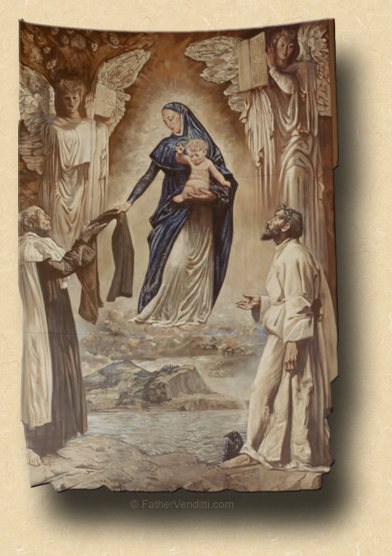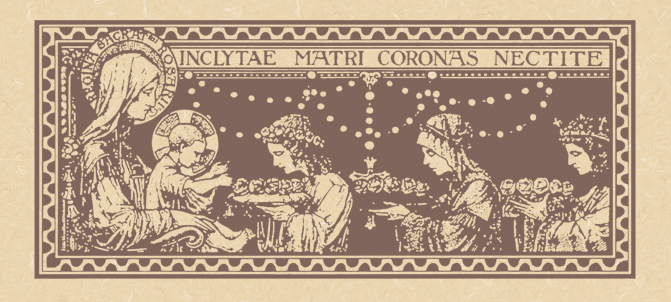The Work-Apron that Became an Armor of Purity.
The Fifteenth Tuesday of Ordinary Time; or, the Memorial of Our Lady of Mount Carmel.
Lessons from the proper, according to the ordinary form of the Roman Rite:
• Zechariah 2: 14-17.
• [Responsorial] Luke 1: 46-55.
• Matthew 12: 46-50.
|
…or, lessons from the primary feria:
• Exodus 2: 1-15.
• Psalm 69: 3, 14, 30-31, 33-34.
• Matthew 11: 20-24.
…or, any lessons from the common of the Blessed Virgin Mary.
|
The Fifth Tuesday after Pentecost; and, the Commemoration of Our Lady of Mount Carmel.
Lessons from the dominica,* according to the extraordinary form of the Roman Rite:
• I Peter 3: 8-15.
• Psalm 86: 10, 9.
• Matthew 5: 20-24.
|
If a Mass for the commemoration is taken, lesson from the proper:
• Ecclesiasticus 24: 23-31.
• Benedicta et Venerábilis es…**
• Luke 11: 27-28.
|
FatherVenditti.com
|
 6:59 PM 7/16/2019 — Today we observe the Memorial of Our Lady of Mount Carmel, and the first thing that comes to our minds is the brown scapular associated with Her under that title. 6:59 PM 7/16/2019 — Today we observe the Memorial of Our Lady of Mount Carmel, and the first thing that comes to our minds is the brown scapular associated with Her under that title.
There have been, of course, many different scapulars in the history of the Church; and, as you no doubt know, their origin is that of a monastic garment. It was originally a work apron that a monk wore to protect his habit from being soiled, but, as time went on, came to have a spiritual significance all its own, and became a permanent part of the habits of many different monastic communities. The Brown Scapular of which Our Lady spoke at Fatima is the one associated with the Brothers and Sisters of the Blessed Virgin Mary of Mt. Carmel, known today as the Carmelites; but, the scapular was not a part of their habit from the beginning. The first Carmelite hermits who lived on Mount Carmel in the Holy Land in the 12th century are thought to have worn a belted tunic and striped mantle typical of pilgrims; when the Carmelites moved to Europe in the mid 13th century and became a mendicant order of friars they adopted a new habit that included a brown belted tunic, brown scapular, a hood called a capuche, and white mantle, which is what their habit looks like today.
The special spiritual privileges attached to the Brown Scapular are often believed to originate from an appearance of the Mother of God to St. Simon Stock, who was Prior General of the Carmelite Order in the middle of the 13th century, but there's no real record of this until the 14th century. This tradition states that “St. Simon was an Englishman, a man of great holiness and devotion, who always in his prayers asked the Virgin to favor his Order with some singular privilege. The Virgin appeared to him holding the Scapular in her hand saying, 'This is for you and yours a privilege; the one who dies in it will be saved.'”***
Now, as a secular priest who does not belong to any religious order, I'm always sensitive to the misconception that many people have had over the centuries that, in order for a priest to be truly holy, he needs to belong to some sort of religious order, like the Carmelites or the Franciscans or the Dominicans or the Benedictines or the Jesuits; and, throughout its history, the Church herself has had to condemn several times the notion that crops up every hundred years or so that the secular priest, because he doesn't live in a monastery according to some sort of monastic rule, is spiritually inferior. That being said, it is a fact that, throughout the history of the Church, many priests and lay people alike have found great spiritual help in associating themselves with the unique spiritual program of one religious order or another, which, toward the end of the Middle Ages, would give rise to what would eventually be known as the Third Orders:  the First Order was the men who belonged to a monastic community, the Second Order was the women or nuns who belonged to it, and the Third Order consisted of lay people and secular priests who wanted to share, in their own way, in the spiritual life of that community; and, as a sign of their participation in that spirituality, those who joined these Third Orders were sometimes given a modified portion of that community's monastic habit to wear underneath their secular clothing. In the case of the Carmelites, that part of the habit they gave people to wear was the Brown Scapular. the First Order was the men who belonged to a monastic community, the Second Order was the women or nuns who belonged to it, and the Third Order consisted of lay people and secular priests who wanted to share, in their own way, in the spiritual life of that community; and, as a sign of their participation in that spirituality, those who joined these Third Orders were sometimes given a modified portion of that community's monastic habit to wear underneath their secular clothing. In the case of the Carmelites, that part of the habit they gave people to wear was the Brown Scapular.
Originally, one could not wear the Brown Scapular unless one had joined the Third Order of Mt. Carmel, and one couldn't join the Third Order of Mt. Carmel unless one had been accepted into it by the superior of a Carmelite Friary. In the 16th century, investiture in the Brown Scapular was restricted even further, and the Carmelites required that Third Order members, whether priests or laymen, had to be invested in the entire habit of the order, and would be vested in it for burial; and that is still true for the members of the Third Order of Mt. Carmel today.
But, because of the special privileges attached to wearing the Brown Scapular according to the tradition of St. Simon Stock—particularly the promise of eternal salvation—the Carmelites were encouraged by the Church to relax their requirements, which they ultimately did, making the Brown Scapular available to everyone provided that they dedicated themselves to living the Catholic Faith to its fullest, with a special emphasis on love for the Mother of God. At one time, in fact, lay people could be commissioned to invest other lay people in the Brown Scapular, but that was recently revoked, and now the Carmelite Order requires that only a priest or deacon can invest someone in the Brown Scapular.
Our Blessed Mother focused on the Brown Scapular to the Three Children at Fatima because she understood that anyone who wore the Scapular in the spirit that it requires would be saved; but, not because the Scapular was some sort of magic charm that had some power of its own to impart grace, but because, as the Catechism of the Catholic Church states, the spiritual program attached to it prepares the soul to receive grace, particularly the Grace of the Sacraments and the Grace of a Holy Death.
The Gospel proper to this Memorial of Our Lady of Mt. Carmel is the famous one which capsulizes the spirit of true devotion to the Mother of God:
As he was yet speaking to the multitudes, behold his mother and his brethren stood without, seeking to speak to him. And one said unto him: Behold thy mother and thy brethren stand without, seeking thee. But he answering him that told him, said: Who is my mother, and who are my brethren? And stretching forth his hand towards his disciples, he said: Behold my mother and my brethren. For whosoever shall do the will of my Father, that is in heaven, he is my brother, and sister, and mother (Matt. 12: 46-50 DRA†).

* In the extraordinary form, on ferias outside privileged seasons, the lessons come from the previous Sunday.
** The Gradual is non-Scriptural: "O Virgin Mary, blessed and venerable art thou: who without blemish to thy maidenhood, didst become the Mother of the Saviour. O Virgin Mother of God, He whom the whole world cannot contain, enclosed Himself within thy womb, and became man."
*** Eamon R. Carroll, O. Carm., Medieval Devotion to Mary Among the Carmelites.
† DRA = Douay-Rheims, American Edition, 1899.
|

